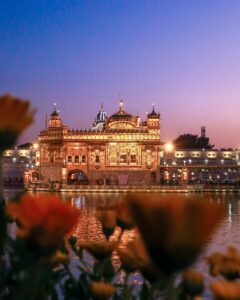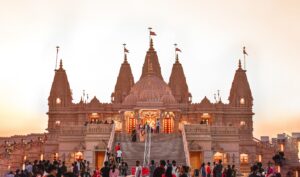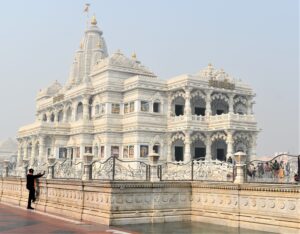India Temples
Indian temples are sacred places of worship and spirituality, with a rich cultural and architectural heritage. They come in various sizes and architectural styles, from the intricately carved stone temples of Khajuraho to the grand temples like the Meenakshi Temple in Madurai. Temples often house deities of the Hindu pantheon, and they play a significant role in religious ceremonies and festivals. Many temples feature stunning sculptures, intricate artwork, and offer a serene atmosphere for meditation and prayer, making them essential centers of devotion and cultural significance in India.
Indians Temples Religious Significance
Indians Temples hold significant religious and spiritual importance in various cultures and religions around the world. The specific significance of a temple can vary greatly depending on the religious tradition, but some common themes include:
- Worship and Devotion: Indians Temples are primarily places of worship and devotion where adherents of a particular religion come to offer prayers, make offerings, and seek spiritual guidance. They serve as a space for the congregation to connect with the divine.
- Sacred Space: Temples are considered sacred places, often believed to be the dwelling or abode of deities or a link between the earthly and the divine realms. Worshipers enter temples to communicate with the divine, seek blessings, and perform religious rituals.

- Ceremonies and Rituals: Temples are centers for religious ceremonies and rituals. These rituals can include daily prayers, festivals, pilgrimages, and other religious practices that are essential religious tradition.Rituals in temples can vary significantly depending on the specific religious tradition and the cultural practices of the region.
- Community and Fellowship: Temples often serve the as gathering places for religious communities. They bring people of the same faith together, fostering a sense of community, and provide opportunities for religious education and social interaction.
- Education and Spiritual Learning: Many Indians temples also function as centers of religious education, where priests or religious leaders teach the scriptures, theology, and ethical principles of the faith.
- Symbolism and Art: Temples are often adorned with intricate artwork, statues, and architectural features that have deep symbolic significance. These symbols can help convey religious teachings and stories.
- Spiritual Pilgrimage: Some temples are considered pilgrimage sites, drawing devotees from distant places who seek spiritual growth and blessings by visiting these sacred locations.Temples play a significant role in various spiritual and religious traditions around the world. The spirituality of temples varies depending on the specific belief system and cultural context, but there are common themes and principles that often apply.
- Meditation and Contemplation: In some traditions, temples provide a tranquil environment for meditation and spiritual reflection. They serve as places for individuals to seek inner peace and connect with the divine through personal contemplation.
- Sacred Space: Temples are considered sacred spaces where the divine presence is believed to reside. The architecture, design, and layout of temples are often carefully planned to create an atmosphere of holiness and reverence. This sacred space is intended to facilitate a deeper connection with the divine.
- Generosity and Charity: Some Indians temples also engage in charitable activities, helping the less fortunate and promoting a sense of community service and compassion.
- Symbolism and Iconography: Temples are often adorned with symbolic artwork and icons representing the deity or deities they are dedicated to. These symbols help convey the teachings and stories of the faith, serving as a visual aid for meditation and contemplation.
- Preservation of Tradition:Temples can serve as custodians of religious traditions, preserving ancient rituals, scriptures, and cultural practices for future generations.
- Meditation and Contemplation: Temples offer a serene and peaceful environment for meditation and contemplation. Many people visit temples to seek inner peace, clarity, and spiritual insight. The stillness and tranquility of the temple can help individuals connect with their inner selves and the divine.
It’s important to note that the significance of a temple can vary widely from one religion to another and even among different sects or denominations within the same faith. Additionally, the architectural style and practices associated with temples differ across cultures and regions, further reflecting the diversity of religious beliefs and practices.
Indians Temples Architectural Features:
The specific characteristics can vary widely depending on the region, religion, and time period, but here are some common architectural and historical features of temples:
- Sanctum Sanctorum (Garbhagriha): This is the innermost chamber of the temple, where the main deity’s idol or symbol is enshrined. It’s the most sacred part of the temple. Temples serve as centers of worship, meditation, and community gatherings, fostering spiritual growth and cultural preservation.
- Gopuram or Shikhara: The monumental entrance or tower, often elaborately decorated with sculptures, reliefs, and intricate carvings. It serves as a prominent feature of many South Indian temples.

- Mandapa: An open or closed hall used for prayer and rituals. Mandapas can be supported by ornate pillars and house smaller shrines and statues.
- Vimana or Spire: The towering superstructure over the sanctum sanctorum, which is often pyramid-shaped or curved. It symbolizes the connection between the earthly and divine realms.
- Courtyard: An open space within the temple complex where devotees gather, perform rituals, and participate in religious activities.
- Sculptures and Carvings: Indians Temples are known for their intricate carvings and sculptures, depicting various mythological stories, deities, and religious themes.They feature intricate carvings, vibrant artwork, and ornate designs, reflecting the country’s artistic heritage.
- Prakara or Compound Wall: A surrounding wall that marks the temple’s boundaries and provides a sense of sanctity and security.
- Sikhara (Tower): In North Indian temples, a tower is often used instead of a gopuram. These towers are usually curvilinear and can be quite ornate.
Indians Temples Historical Features:
- Religious Significance: IndiansTemples often have deep religious and spiritual significance for the followers of the respective faith. They are places of worship, meditation, and religious rituals.One central aspect of religious signification is the pursuit of meaning and purpose. Religion often offers answers to fundamental questions about the origin of the universe, the nature of good and evil, and the afterlife. For example, Christianity teaches that life has purpose through a relationship with God, while Buddhism emphasizes the path to enlightenment and liberation from suffering.
Religious symbols and rituals play a vital role in signifying a person’s faith. These symbols, whether a cross, a crescent moon, or a sacred text, carry deep meaning and serve as a connection to the divine. Rituals, such as prayers, fasting, or pilgrimage, provide individuals with a sense of belonging and identity within their religious community.
- Historical Timeline: Indians Temples can have a long history, with some dating back thousands of years. They may have witnessed various dynasties, rulers, and architectural changes over time.One central aspect of religious signification is the pursuit of meaning and purpose. This timeline highlights some of the most significant events in human history, reflecting the evolution of civilizations, the rise and fall of empires, and the ongoing progress of human society through the ages. It is important to note that history is a complex tapestry, with many more events and developments than can be included in this brief overview.

- Patronage: Many Indians temples were built with the support of royal patrons, and they reflect the art and architectural styles of their times. Some temples are known for their association with specific rulers or dynasties.Patronage refers to a system in which individuals, organizations, or institutions provide support, typically financial or other resources, to artists, scholars, or other creative professionals. This support enables these individuals to pursue their work and contribute to the cultural, intellectual, or artistic development of society.
Historically, patronage has played a crucial role in the advancement of various fields, including art, music, literature, and science. During the Renaissance, for example, wealthy families and institutions like the Catholic Church provided patronage to renowned artists like Leonardo da Vinci and Michelangelo, which allowed them to create masterpieces that continue to be celebrated today.
In addition to fostering artistic and intellectual endeavors, patronage has often been a means of social and political influence. Patrons have used their support to endorse and promote ideas, causes, or individuals aligned with their interests. This influence has shaped the direction of cultural and intellectual movements throughout history.
- Artistic Heritage: Indians Temples are significant repositories of art and culture. The sculptures and carvings found in temples often provide insights into the artistic traditions of the region.Indian temples are diverse architectural wonders, embodying rich cultural and religious traditions. These sacred structures can be found throughout India, representing various faiths like Hinduism, Buddhism, Jainism, and others.
- Religious Practices and Rituals: The historical evolution of religious practices and rituals can often be traced through the inscriptions and records found in temples.Religious practices encompass a wide range of activities that may include prayer, meditation, worship, and acts of devotion. These practices often serve as a means of connecting with the divine, seeking guidance, expressing gratitude, and finding inner peace. They can be both individual and communal, carried out in homes, places of worship, or sacred sites.
Rituals, on the other hand, are formalized actions and ceremonies that follow prescribed patterns and symbolize significant aspects of a religion. These may include rites of passage like baptism, marriage, and funerals, as well as seasonal observances, such as Christmas, Ramadan, or Diwali. Rituals are often designed to mark transitions, celebrate events, or strengthen the bonds within a religious community.
- Cultural Identity: Indians Temples are an integral part of the cultural identity of a region. They often serve as cultural and social hubs for the local community.Visitors from around the world are drawn to these temples for their spiritual significance and architectural splendor.
- Restoration and Conservation: Many ancient Indians temples require ongoing restoration and conservation efforts to preserve their historical and architectural value.
- Religious and Cultural Festivals: Indians Temples are the focal points of religious and cultural festivals. These events can attract pilgrims and tourists from around the world.

It’s important to note that the features of Indians temples can vary widely between different cultures and religions. Hindu temples, Buddhist stupas, Islamic mosques, Christian churches, and other religious structures all have their own unique architectural and historical characteristics.
Content AI
Indian temples are an integral part of the country’s rich cultural and religious heritage. They vary in size, architectural style, and significance, but they all play a vital role in the religious and social life of the Indian people. Here’s some content about Indian temples in English:
1. Historical Significance: Indian temples have a long and diverse history, with the earliest temples dating back to over 2,000 years ago. The construction and evolution of temples in India have been influenced by various dynasties, empires, and architectural styles. Some of the most famous temples, such as the Kashi Vishwanath Temple in Varanasi and the Badrinath Temple in Uttarakhand, have been revered for centuries.
2. Architectural Diversity: One of the remarkable aspects of Indian temples is their architectural diversity. India has a plethora of temple styles, including Dravidian, Nagara, and Vesara. The Dravidian style, seen predominantly in South India, is characterized by its towering gopurams (entrance towers) and intricate sculptures. The Nagara style, found in North India, is known for its curved spires. Vesara style combines elements of both Dravidian and Nagara styles.
3. Spiritual Significance: Temples in Indians temples serve as places of worship and spiritual reflection for people of various faiths, including Hindus, Jains, Buddhists, and Sikhs. These temples are often dedicated to specific deities, and each temple has unique rituals and customs associated with it. Pilgrims from all over the world visit famous temples like the Amarnath Temple in Jammu and Kashmir or the Golden Temple in Amritsar.
4. Temple Festivals: Indian temples are known for their vibrant festivals and celebrations. Temples host numerous festivals throughout the year, and these events often involve processions, music, dance, and elaborate decorations. For example, the chariot festival at the Puri Jagannath Temple in Odisha is world-famous.
5. Iconic Temples: Indians temples is home to numerous iconic temples that are famous worldwide. Some of these include the Taj Mahal, a UNESCO World Heritage Site that combines elements of Islamic and Indian architecture; the Meenakshi Amman Temple in Madurai, known for its breathtakingly detailed sculptures; and the Konark Sun Temple in Odisha, celebrated for its sun-inspired design.
6. Temple Rituals and Practices: Each temple has its own unique set of rituals and practices, which are an essential part of the religious experience. These may include daily prayers, offerings, and the performance of pujas (ritual ceremonies). Temples also often have priests who guide devotees in performing these rituals.
7. Spiritual Tourism: Indians temples are a significant part of India’s tourism industry, attracting millions of visitors each year. Many tourists, both domestic and international, explore India’s temples not only for their religious significance but also for their architectural and cultural value.
8. Conservation Efforts: Preserving and maintaining these ancient structures is of utmost importance. Many organizations and government bodies in India are dedicated to the conservation and restoration of temples to ensure that they continue to stand as symbols of India’s cultural heritage.
Indian temples hold a special place in the hearts of the Indian people, and they continue to be a source of spiritual solace, cultural pride, and historical significance. These places of worship and cultural heritage are a testament to the rich and diverse tapestry of India’s history and spirituality.
